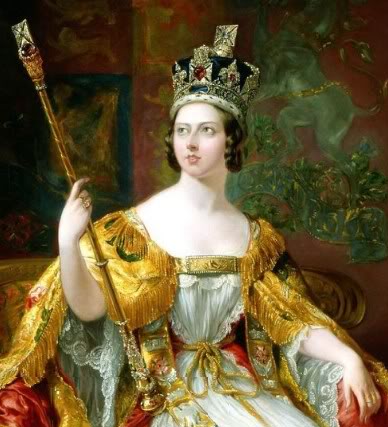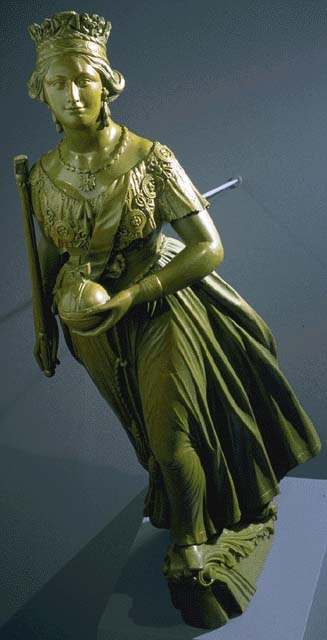Hey everyone! This post I am very excited about because it is my absolute favorite figurehead that we have here in our collection! This figurehead of Queen Victoria not only interests me because of the historical significance of the Queen, but the detail of the carving is beautiful.
The figurehead is in a walking position with her long luxurious dress blowing in the wind, making her look very realistic. She is ordained in jewels and the top of the dress is covered in roses. The Queen is holding an orb, an emblem of sovereignty, which is a dead giveaway that this was in fact a queen. Also another tell-tale sign is the crown atop her head (duh). The detail is incredible on this carving, and even though it is hard to see in the photograph, the artist included a carving of the patron saint of England, St. George. The image shows the saint on horse back slaying the dragon, located just on the waist of Queen Victoria. Back in her day, this figurehead was probably painted all white, but today she remains in a dark greenish-color. She was once displayed in the Great Hall of the Mariners’ Museum, but now remains “Hidden in the Hold.”
For a little background on the real Queen Victoria; she was the queen of the United Kingdom of Great Britain and Ireland and empress of India. She was the only child of Edward, Duke of Kent, the fourth son of King George VII. Queen Victoria was ordained in 1837 and married Prince Albert of Saxe-Coburg-Gotha (her first cousin, ew!) with whom she had nine children (also gross!). After Albert died in 1861, she went into a deep period of mourning and lost some popularity until near the end of her regime as queen. She ruled until the time of her death in 1901, and was succeeded by her son Edward VII, for a total reign of 63 years.
Returning to our figurehead, this particular one was made for a very important British ship called British Queen. The ship was a wooden paddle steamer and was the largest and most luxurious ship of its time (it was 36 feet longer than any ship in the British Navy), created in 1838. Her creator, Junius Smith, made the ship with the hopes of receiving “royal favors” from the Queen, which is probably why he commissioned the figurehead of Queen Victoria. British Queen, made nine trips from England to New York, but stopped running due to financial problems of the company, and as a result the figurehead was removed (which is why it has been so well preserved).
But how do we know that it is Queen Victoria?
Based on the date it was created, we known that it was right after Queen Victoria had taken her place at the thrown. We also known that Junius Smith was seeking favors from the crown, and took this opportunity to suck up to the queen as much as possible (we do not know what the favor was or if it worked, just that she was flattered). Based on the appearance of the figurehead, we are sure that it was intended to be a portrait of the queen, and therefore it must have been intended.
Our figurehead was used in Byron Miller’s Sail, Steam and Spledor in 1977, which you could check out for more information about transatlantic liners.

